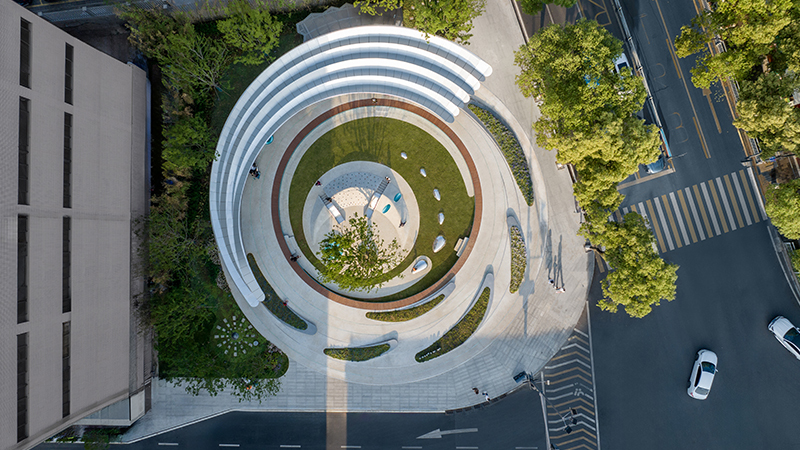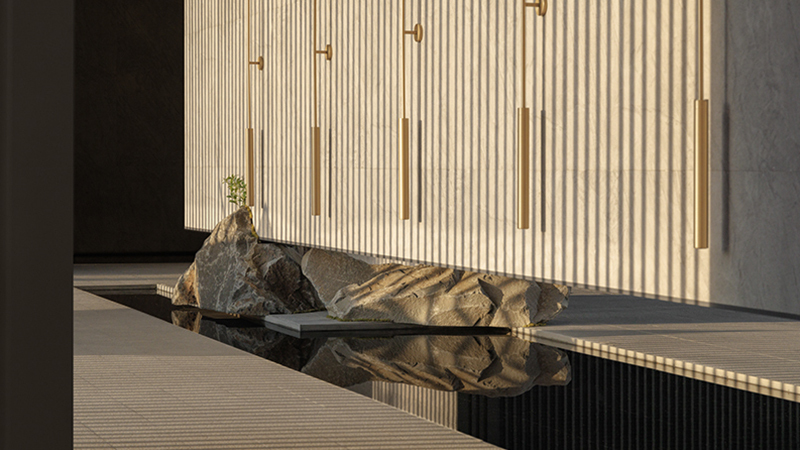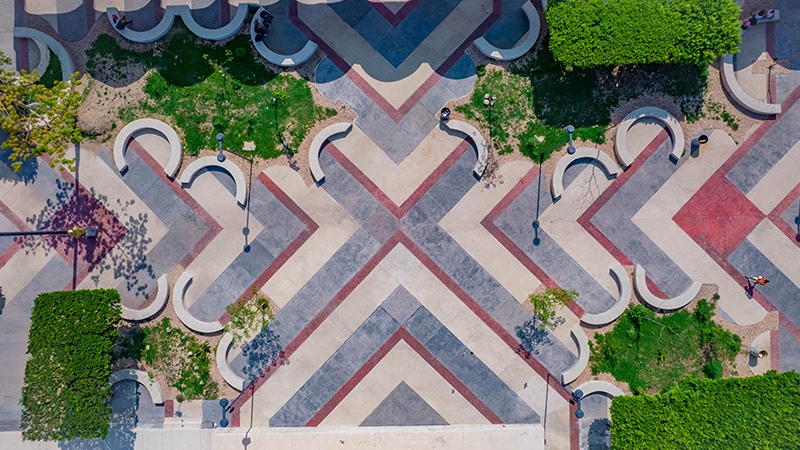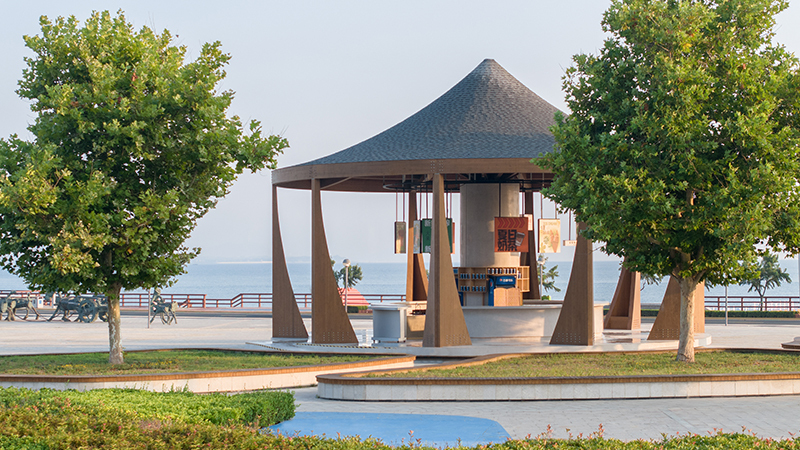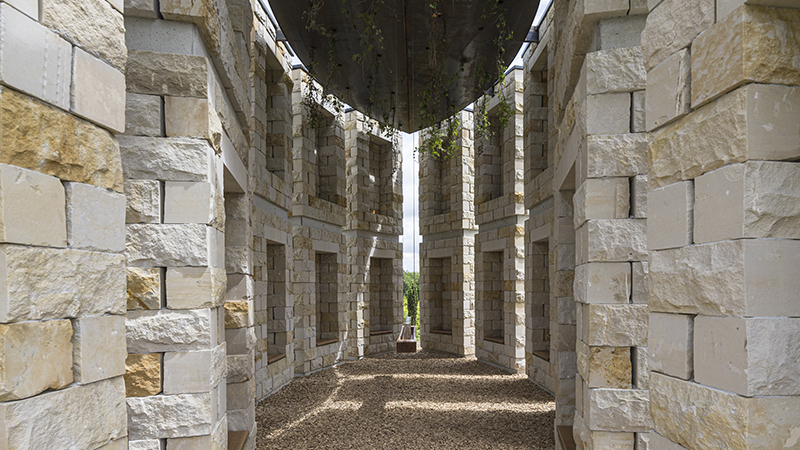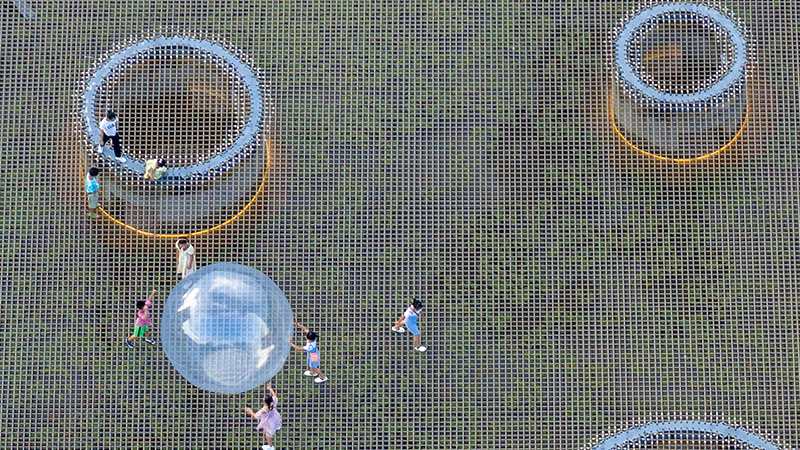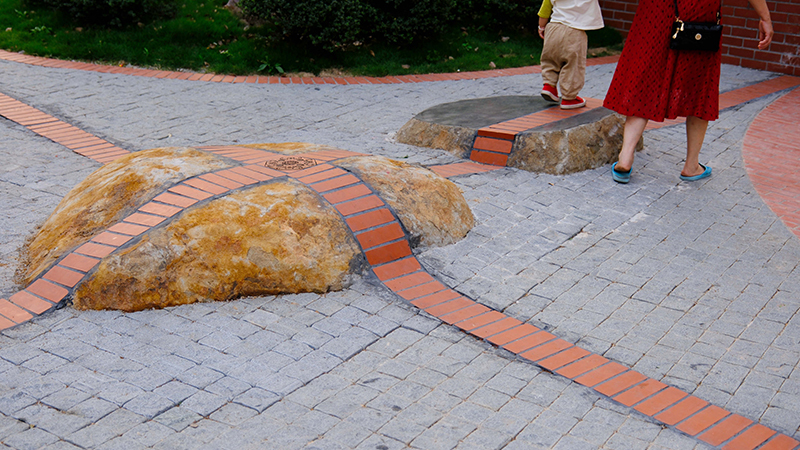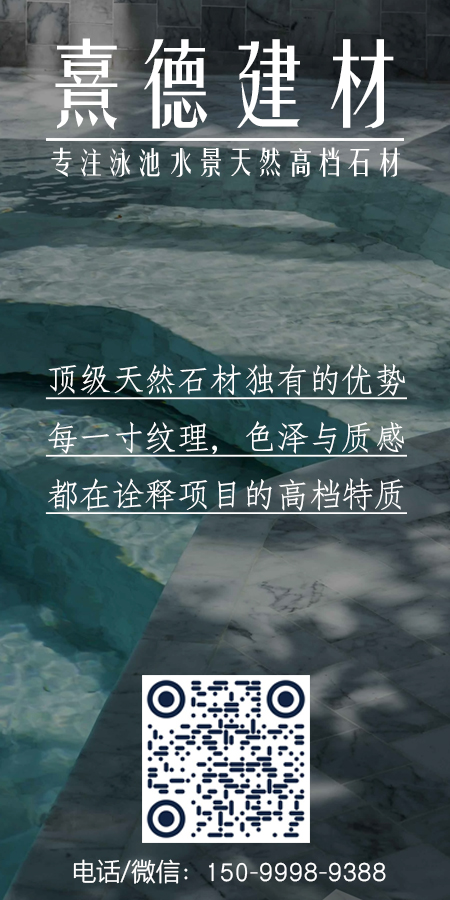城市是巨大的自然现象,超越人类设计能力 。规划者需敬畏城市自生秩序,以 “小而灵活的更新” 取代宏大蓝图,在混合用途、高密度交互、历史层积中培育有机多样性——这才是城市对抗死寂、永续繁荣的生命密码。
——简·雅各布斯《美国大城市的生与死》
Cities are immense natural phenomena that surpass human design. Planners must respect their emergent order, replacing grand blueprints with "small and flexible interventions." It is within mixed uses, dense interactions, and historical layering that organic diversity thrives—this is the vital code for a city to resist stagnation and decline and ensure its perpetual vitality.
— Jane Jacobs, The Death and Life of Great American Cities
-项目背景-
Background
兴安广场位于夷陵三巷核心老城的南侧,紧邻城市核心主干道夷兴大道,是夷陵三巷城市更新项目的重要节点。在《未来简史》中,尤阿尔赫拉利这样评价过去对我们的影响:“过去是从先辈的祠堂里伸出的手,固定住我们的视线,让我们只能看到某个未来的方向。我们从出生那一刻就能感受到这股力量,于是以为这就是自然,是我们不可分割的一部分。”在面对核心老城改造的城市更新项目时,我们也时常能感受到这股力量,充满惯性地固执地带着城市生活奔向熵增的方向。城市更新的不断进程就是要打破这样的结局,让城市的发展成为螺旋上升的曲线,而非一贯的下坠。
Xing'an Plaza is situated on the south side of the core old town of Yiling Third Lane, adjacent to Yixing Avenue, the city's main arterial road. It serves as a key node in the urban renewal project of Yiling Third Lane. In Homo Deus, Yuval Harari reflects on the influence of the past:"The past is a hand reaching out from the ancestral shrine, fixing our gaze and limiting our vision to certain future directions. We feel this force from the moment we are born, and thus perceive it as natural—an inseparable part of ourselves."
In urban renewal projects focused on transforming historic city centers, we often sense this same force—persistent and inertial, pulling urban life toward entropy. The ongoing process of urban renewal aims to break this trajectory, transforming the city’s development into an ascending spiral rather than a consistent decline.
△ 区位分析及场地项目概览
城市更新不是一蹴而就的节点,是一个螺旋上升的过程,过程中通常会经历若干年的阵痛。兴安广场作为夷陵三巷城市更新项目的首发项目,自2023年起便开始整修,当项目交由我们时,已经成为集夷陵三巷入口集散、夷兴大道形象界面展示、林下休憩活动、咖啡餐厅户外经营等多个功能叠加的复合型空间。此处,老城原住民的户外休憩需求、业态更新带来的空间诉求、夷陵三巷整体片区风貌对这个场地的定位等等要求,叠加在这个不到3000平的场地上,现状明显已经不能满足这些多元复合的需求。
Urban renewal is not an overnight achievement but an iterative and evolving process, often accompanied by years of growing pains. As the pilot project of the Yiling Third Lane urban regeneration initiative, Xing'an Plaza has been undergoing renovations since 2023. By the time it was handed over to our team, it had already been transformed into a multifunctional space combining several roles: a gathering and distribution point at the entrance of Yiling Third Lane, a visual frontage along Yixing Avenue, a shaded rest and activity area under tree canopy, and a zone for outdoor dining and café operations.Here, multiple demands converge on this site of less than 3,000 square meters—the need for outdoor leisure among long-term residents, new spatial requirements brought by business transformation, and the role assigned to this space within the overall streetscape renewal of the Yiling Third Lane district. The current state of the plaza clearly falls short of meeting these complex and layered expectations.
△ 项目概览
-场地现状-
Site Analysis
场地南临夷陵区核心主干道夷兴大道,东侧的老街是老城的重要商业街区,西侧的夷陵二巷是老城的重要交通要道。此处复杂的车流、人流、业态带来了多元复合的功能需求。
The site is bordered by Yixing Avenue, the core arterial road of Yiling District, to the south. To the east lies the Old Street, an important commercial district of the old town, while to the west runs Yiling Second Lane, a major thoroughfare in the historic urban area. The complex flows of vehicles and pedestrians, together with the diverse business activities in the vicinity, generate multifaceted and integrated functional demands for the space.
△ 场地原始照片
我们需要考虑老城原住民的基本需求:比如旁边小旅馆希望自己门前不受干扰,像以前一样有独立空间,比如此处是周边老年人最爱的闲暇休憩场地,就算没有坐凳,他们也会搬着板凳桌椅在广场为数不多的树荫下纳凉,再比如小摊贩的菜摊需求是可以被忽略的,因为随着夷陵三巷的更新,他们会有更好的经营场地。
We must take into account the essential needs of the long-term residents in the old neighborhood. For instance, the small inn nearby hopes to maintain an undisturbed and independent space in front of its premises, as it has always had. Likewise, this area serves as a favorite leisure spot for the elderly in the community—even in the absence of formal seating, they bring their own stools and chairs to relax under the limited shade of the plaza’s trees. As for the vegetable vendors, while their need for space might seem negligible now, it will be addressed as part of the broader renewal of Yiling Third Lane, where improved vending areas will be provided.
我们也必须融合局部业态更新带来的空间需求:广场北侧边界是上世纪的民居,为了让老城更加吸引年轻人,成为未来年轻人生活休闲的打卡点,也为了迎合了旁边即将出现的青年公寓,如今改造为早C晚A的咖啡餐厅,这样的功能变化自然也对场地提出了新的需求。这也带来了改造过渡期的空间使用矛盾:咖啡餐厅经营者希望自己的外部环境是品质有活力的,耄耋老者坐在门口的景象明显与期待不符。迫不得已,咖啡餐厅经营者在自家门口围合出了临时的户外经营空间。另外咖啡餐厅经营者强烈要求在广场上开辟出独属的停车位,这确实是一个有待商榷的需求,因为他会剥夺大部分人对广场功能的使用。
We must also integrate the spatial demands arising from localized commercial renewal. The northern edge of the plaza is lined with residential buildings dating back to the last century. In order to make the old neighborhood more appealing to young people—turning it into a future lifestyle destination—and to align with the upcoming youth apartment complex next door, the space has been repurposed into a “morning coffee, evening alcohol” café and restaurant. This functional shift naturally introduces new requirements for the site.However, it has also led to spatial conflicts during the transitional phase of renovation. The café operator desires an upscale and vibrant exterior atmosphere, while the presence of elderly residents gathering at the entrance clearly contradicts this vision. As a temporary solution, the café has delineated a makeshift outdoor dining area in front of its premises.Additionally, the operator has strongly requested dedicated parking spaces within the plaza—a contentious demand, as it would encroach upon the public functionality of the space for the broader community.
正如简雅各布在城市经济中说的,“ 城市的多样性从何而来?人们有着不同的品味和需求,利用不同的技能提供各种服务,怀着不同的梦想紧紧聚在一起,这才造就了城市的参差多态。”通过多年的城市更新,各种品味、需求、技能、梦想的人被城市邀约到这个广场上,展开自己的公共空间生活,而我们现在要做的,就是找到他们各异的生活范式中的共同点,让他们乐意在城市街角发生自己的生活。
As Jane Jacobs articulated in The Economy of Cities,“What makes cities diverse? It is the gathering of people with different tastes and needs, employing varied skills to offer distinct services, and holding diverse dreams—this is what creates the rich and vibrant tapestry of urban life.”Through years of urban regeneration, individuals of varying tastes, needs, skills, and aspirations have been drawn by the city into this plaza, each unfolding their own form of public life. Our task now is to identify the common threads within these diverse patterns of life, and to shape a space where they willingly choose to unfold their stories—right here, at this urban street corner.
-设计挑战-
Design Challenge
1)如何构建新兴商业与周边居民需求的共生关系
随着当下政府财政负担日益加重,推动公共空间探索社会化运营模式成为关键课题。 面对夷陵三巷城市更新中公共空间运维成本攀升、服务升级需求迫切的现状,政府引入社会资本参与其中,以市场化手段破解公共空间可持续运维难题,于是广场上通过升级普通民房打造成了咖啡餐厅。在这样的背景下,在兴安广场的设计中,景观设计师面临的挑战从单纯的营造公用活动空间转向平衡公共空间公益属性与商业活力,通过创新设计实现社会价值与经济收益的共生循环,构建和谐的共生关系。
1)How to Build a Symbiotic Relationship Between Emerging Businesses and the Needs of Surrounding Residents
Given the increasing fiscal burden on governments, promoting the exploration of socialized operation models for public spaces has become a critical issue. Confronted with the rising operational costs and urgent need for service upgrades in the public spaces of the Yiling Third Lane urban renewal project, the government has introduced social capital to address the challenge of sustainable maintenance through market-oriented approaches. As a result, a café-restaurant has been created in the plaza by upgrading an existing residential building.In this context, the challenge for landscape architects in the design of Xing'an Plaza has shifted from merely creating public activity spaces to balancing the public welfare nature of these spaces with commercial vitality. Through innovative design, the goal is to achieve a symbiotic cycle of social value and economic benefits, thereby fostering a harmonious coexistence.
2)如何实现容纳"所有人"的多元包容的空间
传统的设计往往会在空间中划分功能,来试图规训每种类型人群的使用空间和范围,以求达到每个人都能在空间中找到属于自己的位置。但在这个项目里空间是复合多元的,如果我们只让咖啡馆的人待在咖啡馆里,而周边的人没有前往咖啡馆的欲望只在边界休憩,城市边界就只是城市边界,咖啡馆就只是咖啡馆,那这个设计是失败的。所以设计师面临的挑战在于,如何通过创新设计,让公共空间充满吸引力,即让咖啡馆的消费空间自然而然的蔓延至公共空间。
2)How to Achieve a Diverse and Inclusive Space that Accommodates "Everyone"
Traditional design often compartmentalizes space to regulate the areas and scope of use for different groups, aiming to ensure everyone can find their own place. However, in this project, the space is multifunctional and complex. If we confine café-goers to the café while surrounding residents remain unwilling to approach—lingering only at the edges—then the urban boundary remains just a boundary, and the café remains just a café. Such an outcome would signify a failed design.Thus, the designer’s challenge lies in creating innovative solutions that make public space genuinely appealing—allowing the commercial atmosphere of the café to extend naturally into the public realm, inviting interaction and dissolving barriers.
3)如何定义能被共同认可的老街风貌
传统的夷陵三巷老街该以何风貌呈现在人们眼前,一直是设计前期探讨的重点。单纯作为旅游景点来打造,我们大可以大手一挥让其展现出非日常的外表,与众不同抓人眼球。但这或许不是作为日常使用的人群可以接受理解的,让每天买菜路过的地方展现出过于超现实的景象,似乎也是一种冒险。所以如何找准老街风貌,让此处既有日常的温润烟火又有非日常的优雅特别,是一挑战。
How to Define a Shared Vision for the Old Street’s Character
A central issue in the early design phase was how the traditional Yiling Third Lane Old Street should present itself. If the goal were simply to create a tourist attraction, we could easily give it a strikingly unusual appearance—something extraordinary and eye-catching. Yet such an approach might not resonate with those who use the space daily. Turning a familiar route where people buy groceries every day into an overly surreal environment would be risky.Thus, the true challenge lies in defining an identity for the old street that balances the warm, lived-in feel of everyday life with a touch of elegance and the extraordinary.
△ 兴安广场设计范围
-设计策略-
Design Strategy
1)多元包容的城市客厅,公共与消费的非零和博弈
前来消费的年轻人与生活在周边的老年人不应该是城市空间使用权的竞争关系。他们理应可以在空间中成为良性的互补。设计在空间中做了从公共极到消费极的空间渐变,模糊了这两者之间的边界。由此咖啡馆的年轻人可以端着咖啡杯在廊下看人来人往,周边的原住民可以在沿街桌椅上打牌斗趣。同时设计认为当公共空间足够吸引人,消费空间足够开放,这两者之间的矛盾自然会消解。因此可露天光的建筑灰空间廊架与沿街的休憩空间必须互相融合互为一体,咖啡馆的经营空间可以蔓延至人行道,沿街的公共休憩区可以延伸至建筑边界的灰空间,而廊架的存在,天然的让咖啡馆具有了一定的户外领域感。敏感的咖啡馆运营者在初期可能会为自己围合上花箱,但随着业态的更替、周边青年公寓的建成,相信他会逐渐拆除这道内心的围挡。
1) An Inclusive Urban Living Room: A Non-Zero-Sum Game Between Public Use and Commercial Activity
Young visitors and elderly residents should not compete for the use of urban space—they can and should complement one another in a well-designed environment. The design introduces a spatial gradient ranging from fully public areas to commercial zones, deliberately blurring the boundaries between the two. As a result, young café-goers can enjoy their coffee under the arcade while watching the world go by, and longtime residents can play cards or chat at seating along the street.The design is grounded in a key insight: when public space is inviting and commercial space is open and permeable, the tension between the two naturally dissolves. To this end, the arcade—a semi-outdoor architectural “gray space”—must blend seamlessly with the street-side seating areas. The café is encouraged to extend its service zone out to the sidewalk, while public seating is designed to reach into the building’s edge. The arcade, in particular, lends a natural sense of enclosure to the café’s outdoor area.In the initial phase, cautious operators might place flower boxes to delineate their territory. But as the commercial environment matures and new youth apartments open nearby, we believe those self-imposed barriers will gradually come down.
△ 多元包容的城市客厅
2)丰富多样的城市客厅家具:桌子、椅子、吧台、卡座、阳伞、红毯与花园
一个多元包容的城市客厅,包含“客厅的桌椅、客厅的红毯、客厅的花园、客厅的阳伞”。应当有适合老年人坐着休憩、闲聊甚至打牌的空间,也应当有适合年轻人坐下打卡、倚靠、消费的优雅咖啡吧台,这些休憩空间也应当有足够的遮荫,让烈日炎夏、寒冬雨季都可以留着人群。地面有专属肌理的地面铺装,让某些位置成为独特的场域甚至舞台。
2) Diverse and Versatile Urban Living Room Furnishings: Tables, Chairs, Bar Counters, Booths, Umbrellas, “Red Carpets,” and Gardens
An inclusive urban living room should be equipped with “the seating of a living room, the red carpet of a living room, the garden of a living room, and the umbrellas of a living room.” It must offer spaces where the elderly can sit, rest, chat, or even play cards, as well as elegant coffee counters where young people can settle down, take photos, lean back, and enjoy refreshments. These resting areas should also provide ample shade, ensuring they remain inviting whether under the scorching summer sun or during cold, rainy winters.The ground surface incorporates distinctive textured paving that turns certain spots into unique zones—even stages—for activity and gathering.
△ 多人聊天的卡座
3)红灰色调,峡江记忆的延续
基于整个夷陵三巷的定调,兴安广场整体风格被定义为融合式的峡江文化风。所谓峡江文化,本身就是一个多元复合型的文化基因,1970年为兴建葛洲坝工程,宜昌将县城从城区搬迁至城区西北十公里处,也就是现在的小溪塔。青砖、红砖、峡江建筑独有的文化符号,是曾经刻画在人们脑海中的特殊色彩肌理记忆。我们提炼了视觉元素上的红灰色调,作为场地的底色,统一整个空间的氛围、质感和装饰语言,也为接下来的夷陵三巷改造打好了基调和模板。
3) Red and Gray Tones: Continuing the Memory of Xiajiang Culture
In line with the overall design direction of Yiling Third Lane, Xing'an Plaza adopts an integrated style inspired by Xiajiang culture—a inherently diverse and composite cultural gene. In 1970, to facilitate the construction of the Gezhou Dam project, Yichang relocated its county seat to a location ten kilometers northwest of the urban center, now known as Xiaoxita.The blue bricks, red bricks, and distinctive architectural symbols of the Xiajiang region form a unique visual and textural memory deeply etched in people's minds. We have distilled this palette into a foundational red and gray color scheme that unifies the atmosphere, materiality, and decorative language of the entire space. This approach also sets a stylistic precedent and template for the ongoing renewal of Yiling Third Lane.
△ 峡江记忆的延续,红灰色基调的空间场景
-设计要素-
Space Design
场地没有用常规的功能分区来划分,而是用休憩方式来进行区分。一套桌椅一种休憩方式,多种功能多种可能。树下休憩,可以是吧台空间,也可以是环形座椅搭配小边桌;活动事件广场,容纳未来多元活动空间;闲聊卡座,是闺蜜团最爱选择的地方;休憩长桌让不同的人有机会一起聊天打牌;充满峡江装饰元素的遮荫伞,让空间更具可停留性。
Rather than dividing the site with conventional functional zoning, the design distinguishes areas based on types of rest and socialization. Each seating arrangement enables a different way of pausing and engaging—multiple configurations create multiple possibilities.Seating beneath trees can function both as a counter space or as circular benches paired with side tables. The event plaza is designed to accommodate a variety of future activities. Chatting booths offer an ideal spot for groups of friends, while long communal tables encourage strangers to play cards or converse together. Shade umbrellas featuring decorative motifs inspired by Xiajiang culture enhance the stayability of the entire space.
△ 空间要素及其细节
- 客厅的桌椅 -
Civic Lounge Furnishings
客厅的桌椅组成了多样化的户外休闲功能,卡座用于多人聊天,长桌可以面对面游戏,吧台是闲逛时的停留,甚至我们在吧台上设计了咖啡杯位。
The furnishings of this "Civic Lounge Furnishings" create diverse opportunities for leisure: booths accommodate group conversations, communal tables invite face-to-face games, and the counter encourages spontaneous pauses—even featuring dedicated coffee cup holders designed for convenience.
△ 兴安广场城市家具参数
△ 可以放置咖啡杯的吧台
△ 可以打牌的长桌
△ 背靠背而坐的休息空间
- 客厅的红毯 -
Civic Floor Tapestry
“客厅的红毯”即是对老街场地肌理的延续和再现,也是对空间使用功能的定义,某一天当人们需要的时候会发现在规制的形状可以成为一个独立的舞台空间。
"The ‘Civic Floor Tapestry’" represents both a continuation and reinterpretation of the old street’s textured paving, while also defining the functional potential of the space. Its defined form allows it to transform, when needed, into an independent stage—ready to host moments of gathering and performance.
△ 兴安广场铺装参数
△ 青砖、红砖等材料体现出峡江建筑文化特殊的色彩肌理记忆
△ 独特的红毯肌理成为活动舞台和事件广场
△ 铺装细节
- 客厅的花园 -
Civic Garden
“客厅的花园”是室内客厅无法实现的空间形式,也是室外城市客厅的独特魅力。在当地两年多的在地景观实践中,我们一直在持续探索不同环境场景下的植物品种配置策略。我们探索自然主义的种植方式来营造强烈的花园氛围。使用了银灰色主题的植物搭配,芙蓉菊、柳叶星河、迷迭香等品种此前当地鲜有使用,但经过当地多个项目实践验证后,我们惊喜的发现他们开始出现在本地苗圃中。其他诸如狐尾天门冬的点缀可增加独特质感,姬小菊带来含蓄的色彩丰富效果。而基于此前项目中大吴风草强劲的长势,本次设计我们减少了用量,但它仍是本次基调品种之一。
"The ‘Civic Garden’" is a spatial experience unachievable in indoor settings, and represents the unique charm of an outdoor urban living room. Through more than two years of hands-on landscape practice in the region, we have continuously explored planting strategies tailored to different environmental contexts.We adopted naturalistic planting designs to create a rich garden atmosphere. A silvery-gray thematic palette was introduced—using species such as Crossostephium chinense, Salix ‘Star River’, and Rosmarinus officinalis, which were rarely seen locally before. To our delight, after being implemented in several projects, these plants have begun to appear in local nurseries. Other accents like Asparagus densiflorus ‘Myersii’ add distinctive texture, while Brachyscome iberidifolia offers subtle yet enriching color. Based on the vigorous performance of Farfugium japonicum in previous projects, we reduced its proportion in this design—though it remains one of the foundational species.
△ 被自然主义花园围合的休憩空间
- 雨水花园 -
Rain Garden
兴安广场雨水花园是一次城市雨水花园小实践,收集雨水后,经蓄水、种植土等层净化,借排水管疏导或渗入原土,助力涵养地下水 。在植物选择上,采用了不同的鸢尾品种组合。而一叶兰、富贵蕨等品种的使用,是平衡功能、美观与经济性的综合考量,此外,之前多次运用成功的熊猫堇,已经证明了其良好适地性和景观表现。
The Xing'an Plaza Rain Garden is a small-scale experiment in urban stormwater management. It captures rainwater, which is then filtered through layers of storage soil and planting media before being diverted via drainage pipes or allowed to infiltrate into the native soil, helping to replenish groundwater.For planting, a combination of various iris species was selected. The use of plants such as Aspidistra elatior and Cyrtomium fortunei reflects a comprehensive consideration of functionality, aesthetics, and cost-effectiveness. Additionally, Viola banksii, which has proven successful in multiple previous projects, continues to be incorporated due to its strong adaptability and reliable ornamental performance.
△ 兴安广场雨水花园分析图
△ 雨水花园科普标识
△ 兴安广场雨水花园剖面图
在兼顾种植美学的基础上,我们一直在项目当地努力寻找适地性强、养护压力小、表现稳定的植物品种和搭配,如果这种持续的尝试可以给当地植物景观体验带来新的参考,我们将十分荣幸。
Building on a foundation of planting aesthetics, we have consistently sought out plant varieties and combinations that are well-adapted to the local environment, require minimal maintenance, and deliver reliable performance. If these ongoing efforts can offer new insights and inspiration for the local planting landscape, we would take great pride in contributing to its evolution.
- 客厅的阳伞 -
Civic Pavilion
“客厅的阳伞”,其装饰性语言控制下的形制,为桌椅花园提供了遮阳空间,让户外场地更有吸引力。"The 'Civic Pavilion'" provides essential shade for seating and garden areas through its aesthetically considered form, enhancing the appeal and comfort of the outdoor space.
△ 遮阳伞参数
-设计落地-
Construction
在这个场地构建过程中,有大量非标物料的落地,包括且不限于遮阳伞、花坛、座椅、铺装。设计在过程中以精细化的场地白模推敲空间尺度分析构成关系,并深入参与到构建的每一个主材和节点把控中。
During the construction of this site, a significant number of non-standard, custom-designed elements were implemented—including but not limited to shade umbrellas, planter boxes, seating, and paving.The design process involved meticulous study and refinement using physical white models to analyze spatial scale and compositional relationships. Furthermore, we maintained deep involvement in the selection of every primary material and the detailing of construction joints.
△ 3D打印场地推敲
△ 主要物料对比选择
△ 主要物料工艺全过程管控
-写在最后-
Afterword
兴安广场的改造,是设计对城市空间多元化与包容性的理解,也是对平衡公共空间公益属性与商业活力的一次实践。诚然城市作为巨大的自然现象,超越了人类的设计能力,设计师能做的就是分析当下的具体需求、结合过去的使用惯性、预判未来的城市发展,让城市空间在时间维度上、人群类别上、空间维度上呈现出多样性的可能,我们希望在通过设计模糊公共与消费之间的边界之后,烟火与优雅可以在空间中得到高度的融合与共存。
The transformation of Xing'an Plaza embodies our understanding of the diversity and inclusivity of urban space, as well as an ongoing effort to balance the public welfare nature of shared spaces with the need for commercial vitality.
Indeed, a city, as a vast natural phenomenon, transcends human design capabilities. What designers can do is analyze present needs, acknowledge existing patterns of use, and anticipate future urban development—enabling the space to unfold across time, across communities, and throughout its physical layers with rich possibilities.
By blurring the boundaries between public and commercial use through design, we aim to achieve a space where vibrancy and elegance highly integrate and coexist.
△ 兴安广场的生活方式
项目档案
项目名称:兴安广场
项目地点:湖北宜昌
设计时间:2024年8月-2024年12月
建成时间:2025年5月
设计面积:约3000平方米
建设单位:宜昌市夷陵区城建项目管理服务中心
景观设计:HID翰地景观
设计团队:吴昊、张璐、何玉江、尚煜坤、沈华枢、郑诗宇、高跃雯、杨彬彬、陈影、尤佳、徐亚罕、彭艳阳
施工单位:湖北涵尚伟建筑工程有限公司
项目摄影:IMA岸木摄影
更新日期:2025-08-21 16:53:37
非常感谢 HID翰地景观 带来的精彩项目, 查阅更多Appreciations towards HID for sharing wonderful work on hhlloo. Click to see more works!























































